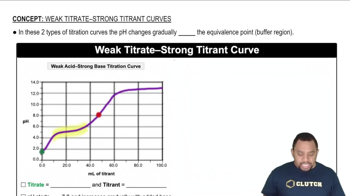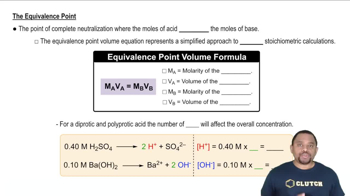Here are the essential concepts you must grasp in order to answer the question correctly.
Strong vs. Weak Acids
Strong acids, like HCl, completely dissociate in solution, while weak acids, such as HF, only partially dissociate. This difference affects the pH at the equivalence point during titration. At the equivalence point, the strong acid will yield a neutral solution, while the weak acid will result in a solution that is more acidic due to the presence of undissociated acid molecules.
Recommended video:
Weak Acid-Strong Base Titration Curve
Titration and Equivalence Point
Titration is a technique used to determine the concentration of an acid or base by neutralizing it with a base or acid of known concentration. The equivalence point is reached when the amount of titrant added is stoichiometrically equivalent to the amount of substance being titrated. This point is crucial for determining the resulting pH of the solution, which varies depending on the strength of the acid or base involved.
Recommended video:
Equivalence Point in Titration
pH and Its Interpretation
pH is a measure of the hydrogen ion concentration in a solution, indicating its acidity or basicity. A pH less than 7 is considered acidic, a pH of 7 is neutral, and a pH greater than 7 is basic. Understanding how the pH changes at the equivalence point of different acid-base titrations is essential for predicting the nature of the resulting solution.
Recommended video:




